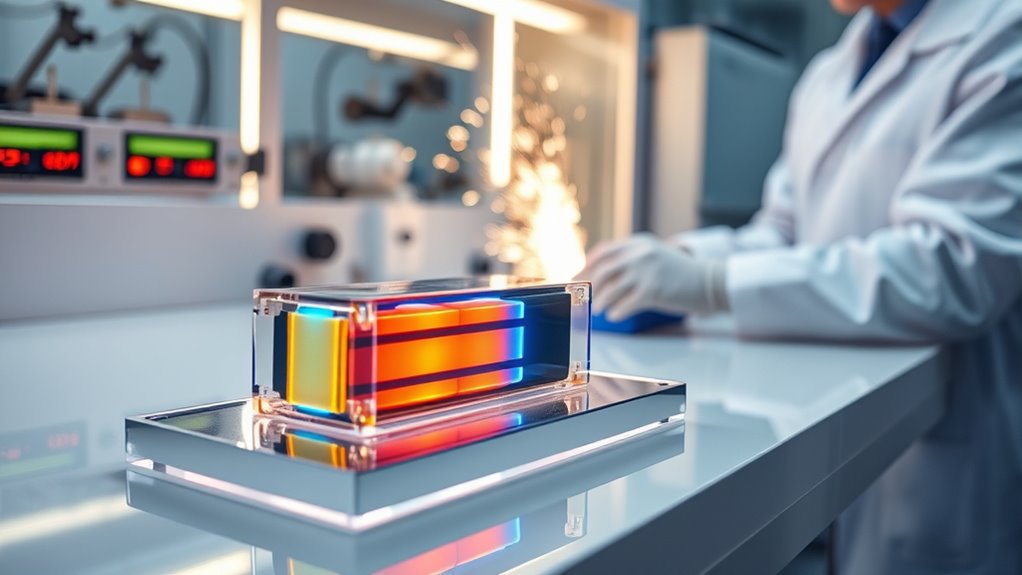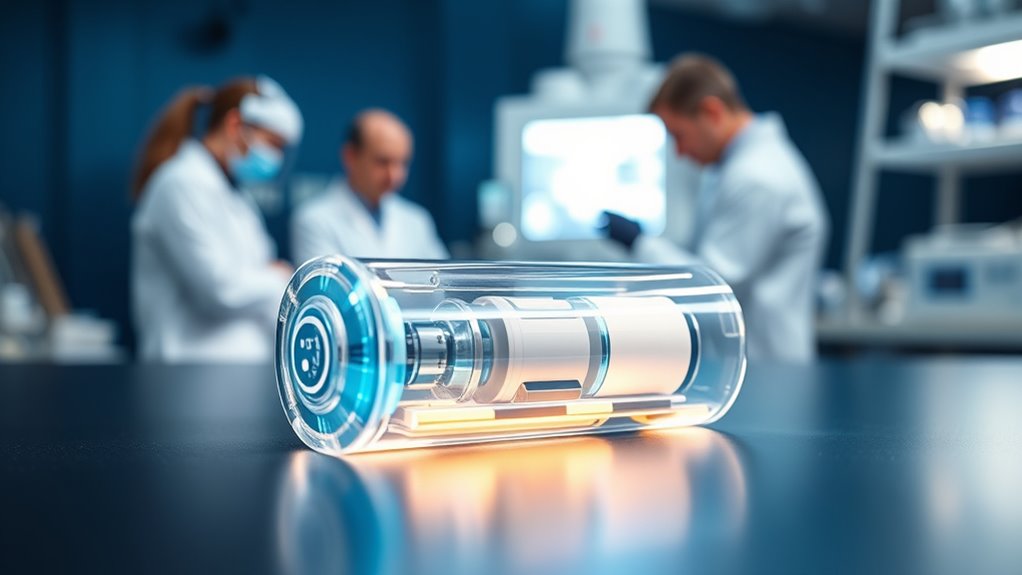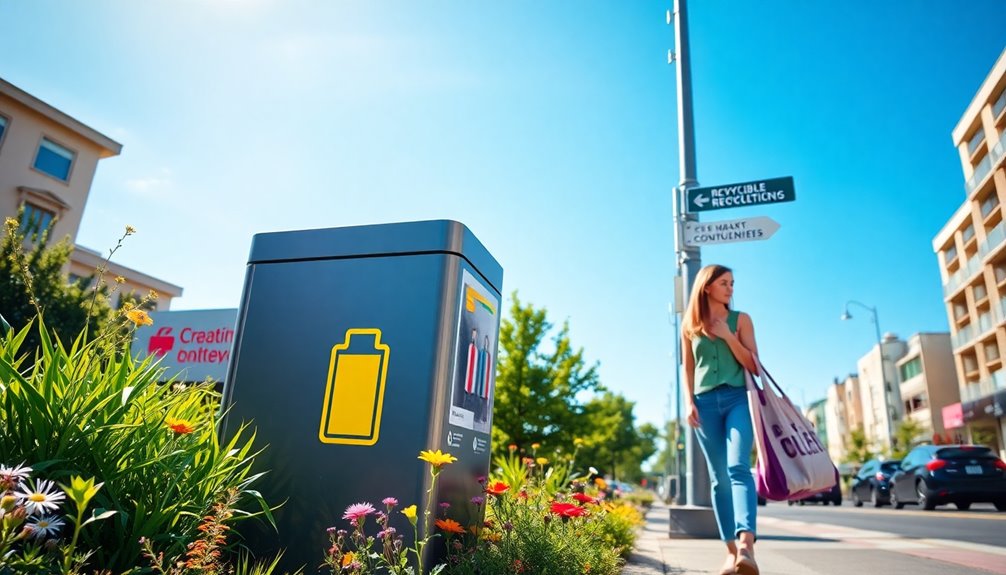Solid-state batteries are generally safer than traditional lithium-ion batteries because they replace flammable liquid electrolytes with solid ones, reducing leak, fire, and explosion risks. However, their safety isn’t guaranteed—manufacturing defects, micro-cracks, or impurities can create weak points that threaten durability and safety over time. While they hold great promise, ensuring consistent, high-quality production is key. If you want to understand how these issues can be managed, there’s more to explore.
Key Takeaways
- Solid-state batteries eliminate liquid electrolytes, significantly reducing fire and leak risks compared to traditional batteries.
- Manufacturing defects and micro-cracks can create safety weak points, potentially compromising their safety advantages.
- Ensuring consistent, high-quality production is challenging, impacting overall safety reliability.
- Higher temperature stability reduces thermal runaway risk, but manufacturing imperfections still pose safety concerns.
- Ongoing research aims to address durability issues, making solid-state batteries safer but not entirely risk-free yet.

Are solid-state batteries truly safer than traditional lithium-ion batteries? When you consider this question, it’s important to look beyond the surface. Solid-state batteries replace the liquid or gel electrolytes found in lithium-ion designs with a solid electrolyte. This fundamental change promises to reduce the risk of leaks, fires, and explosions, making them seem inherently safer. But the reality isn’t quite that simple. You need to understand that while solid electrolytes eliminate some hazards, they also introduce new challenges, particularly around battery durability and manufacturing processes. Online platforms facilitate the exposure of potential issues with these batteries, highlighting the importance of rigorous testing and quality control.
Battery durability plays a vital role in safety. Solid electrolytes tend to be more stable at higher temperatures, which means they’re less likely to degrade quickly or experience catastrophic failures. They’re also less prone to forming dendrites—tiny, needle-like structures that can grow through the electrolyte and cause short circuits. This stability can translate into batteries that last longer and maintain safer operation over time. However, achieving consistent durability isn’t straightforward. Variations in material quality and design can impact how well these batteries perform across different conditions. If the solid electrolyte isn’t perfectly uniform, it might develop micro-cracks or other defects that compromise safety, undermining the very advantages they’re supposed to provide.
Manufacturing challenges are another significant hurdle. Producing solid-state batteries involves complex processes that are still being refined. Creating a uniform, defect-free solid electrolyte at scale demands precise control over materials and techniques. This complexity raises costs and slows down mass production, which limits widespread adoption. These manufacturing challenges also impact battery quality—if the process isn’t consistent, the safety benefits can be diminished. Defects introduced during manufacturing, such as voids or impurities, can create weak points susceptible to failure or thermal runaway. So, while solid-state batteries have the potential to be safer, the shift from lab prototypes to commercial products isn’t seamless. Overcoming these manufacturing obstacles is key to *accessing* their full safety potential.
Frequently Asked Questions
How Do Solid-State Batteries Perform in Extreme Weather Conditions?
You might wonder how solid-state batteries perform in extreme weather conditions, especially cold weather. These batteries offer better thermal stability, meaning they resist temperature fluctuations more effectively than traditional lithium-ion batteries. In cold weather, they maintain efficiency and charge better, reducing performance drops. Their solid electrolyte also minimizes the risk of thermal runaway, making them safer overall, even in harsh climates. So, you can expect more reliable performance when the weather gets extreme.
Are Solid-State Batteries More Cost-Effective Than Traditional Lithium-Ion Batteries?
Ever wondered if solid-state batteries are more cost-effective than traditional lithium-ion ones? The answer depends on the cost comparison and manufacturing costs. While solid-state batteries offer safety and performance benefits, their manufacturing costs are currently higher, making them less economical at scale. However, as production techniques improve, they could become more affordable. So, are they worth the investment now, or will they pay off in the future?
What Are the Environmental Impacts of Manufacturing Solid-State Batteries?
When considering the environmental impacts of manufacturing solid-state batteries, you should know they often use eco-friendly materials, which reduces harmful emissions during production. However, you might encounter recycling challenges because current methods aren’t fully adapted to these new batteries, making disposal more complex. While they promise a greener alternative, you still need to address these recycling issues to truly minimize their environmental footprint.
Can Solid-State Batteries Be Recycled Easily?
Recycling solid-state batteries is like unraveling a tightly woven fabric—you’ll face significant challenges. Their complex materials and advanced technology create recycling challenges, making material recovery more difficult than traditional batteries. Currently, the process isn’t straightforward, and efficient recycling methods are still in development. However, researchers aim to improve material recovery techniques, so someday, you’ll find it easier to recycle these batteries and reduce environmental impact.
How Long Do Solid-State Batteries Typically Last in Real-World Use?
You’re probably wondering about solid-state batteries’ battery longevity in real-world use. They typically last between 5 to 10 years, depending on usage patterns and degradation factors like temperature, charge cycles, and storage conditions. Although they generally degrade slower than traditional lithium-ion batteries, factors like frequent fast charging can still impact their lifespan. Overall, solid-state batteries offer promising longevity, but real-world performance varies based on how you use and care for them.
Conclusion
While solid-state batteries are often touted as safer than traditional lithium-ion ones, they aren’t completely risk-free. Think of them like a sturdy car—less likely to catch fire, but not immune to accidents. Their solid electrolytes reduce the chance of leaks and fires, but issues like dendrite formation still pose risks. So, while they’re safer “ish,” it’s important to remember that no battery is entirely risk-free. Keep safety measures in mind as this technology advances.










